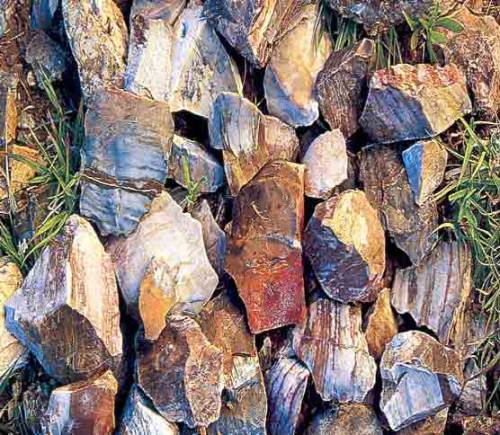Alibates FlintPut yourself in the shoes of a person walking across this landscape 13,000 years ago.
Alibates FlintPut yourself in the shoes of a person walking across this landscape 13,000 years ago. Not much topography, covered by grasses. You see these rocks lying on the surface – do you pay any attention to them?Today, this area is in the Great Plains north of Amarillo Texas and has been recognized as a national monument because of outcrops like these. These photos come from Alibates Flint National Monument – a site that supplied early populations throughout North America with a useful resource – flint.Flint is a type of cryptocrystalline silica, made of the same stuff as quartz but without the rigid crystal structure of a quartz crystal. Flint commonly forms when fluids interact with rocks that have silica in them; the fluids will dissolve silica in one place and precipitate it in others, forming layers of silica that don’t get enough heat to grow big crystals.Because flint isn’t a single crystal like a grain of quartz, it doesn’t break in the same way as quartz – it fractures conchoidally, like obsidian does, allowing it to be whittled into sharp tips and used as spear points, while still retaining some of the hardness and strength of silicate minerals like quartz.Flint grains from this site have been found in archaeological locations throughout the southern U.S. Its earliest use is about 13,000 years ago and it was used up until 1870 as gunflint – a small piece of rock used to make a spark that ignited gunpowder in flintlock muskets.The flint at this location weathers directly out of a layer of dolomite. Dolomites are the altered remnants of limestones – fluids that wind their way through limestone deposits can convert the rock to dolomite. That same process, fluid migration through limestone, was probably able to concentrate some of the silica in the rock into single layers where it formed the flint. Today, the softer dolomite erodes away, leaving piles of flint scattered across the surface.Where the silica in the rock came from isn’t perfectly known – most carbonates form in areas where there is very little siliceous sediment, but it could have been supplied by volcanic ash, which rains down in the ocean even far away from land when there is a large enough volcanic eruption. The dolomites in this area are Permian in age – dating back to the time of Pangea. The volcanoes that could have produced them are long since gone, but the end products shaped trade routes throughout North America during the early days of humanity’s presence in this area.-JBBImage credits:https://de.wikipedia.org/wiki/Alibates_Flint_Quarries_National_Monument?fbclid=IwAR0_6Exm02Yi0EWhne937HTyAAPWGQeQiMoMQkVxBrE6qyL-NdM3h1Xw8AU#mediaviewer/File:Alfl_flint_rocks.jpghttps://www.flickr.com/photos/jstephenconn/2805875827Read more:http://www.nps.gov/getaways/alfl/https://nmgs.nmt.edu/publications/guidebooks/downloads/52/52_p0257_p0264.pdf?fbclid=IwAR0voB3mmTNkvpNN2l46CUItW48FAg4H4nUt6uIGiAIDM_OWO2hc43gEpnUhttp://www.texasbeyondhistory.net/alibates/ -- source link
#flint#chert#geology#sediment#science#silica#fracture#research#arrowhead#gunflint#texas#amarillo#national monument

